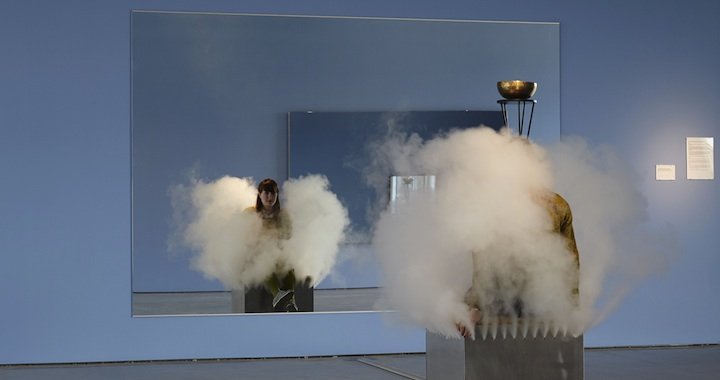
Jeppe Hein and His Happiness
Alida Ivanov
17/05/2013
Jeppe Hein is known for his experimental and interactive art. The pieces can be described as being positioned in the crossroads between art, architecture and technological invention. Even though the works display a formalistic simplicity, they exude a sense of humor and create a dialogue between minimal and conceptual art. For his current exhibition – A Smile for You – at Bonniers Konsthall, in collaboration with Wanås Art, he asked the questions: “What is happiness to you?” and “How does it smell, taste, and feel?” through a public poster campaign; but the show is rooted in a dark, personal and melancholic past. The exhibition is on view at the Bonniers Konsthall until July 28, 2013.
Born in 1974 in Copenhagen, Jeppe Hein shares his time between his hometown and Berlin these days. He studied at the Royal Danish Academy of Art 1997- 2003 and at Städelschule, Frankfurt from 1999-2000. During these years, Hein co-founded OTTO, which was a non-commercial organization that organized art exhibitions in various venues in Denmark.
In the exhibition A Smile for You, he continues to work in a surprising and captivating way, with elements that place the spectators in the center of everything that goes on and puts focus on their experiences and perception of the space itself. The visitors release hanging balls that then run a dynamic course through the space and pass different singing bowls that start to sound whenever a ball collides with them, thereby creating a type of vibrating sound-scape. By creating a meditative state, there is a clear influence from Eastern cultures, as well as references to yoga and Zen Buddhism. But on the other hand, the work “Are you really happy” –black pieces with neon-messages – sends a totally different message. This language is obviously borrowed from the commercial world – the messages lack depth and the pieces become “something pretty”, but stupid. The middle room of Bonniers Konsthall is painted pink and stuffed with drawings and “I'm right here right now”. At first glance, you kind of feel that it’s a joke: something this ugly and poorly-framed should not be on display. But when you look at the dynamic of this diary-piece, it becomes a sort of work of genius.
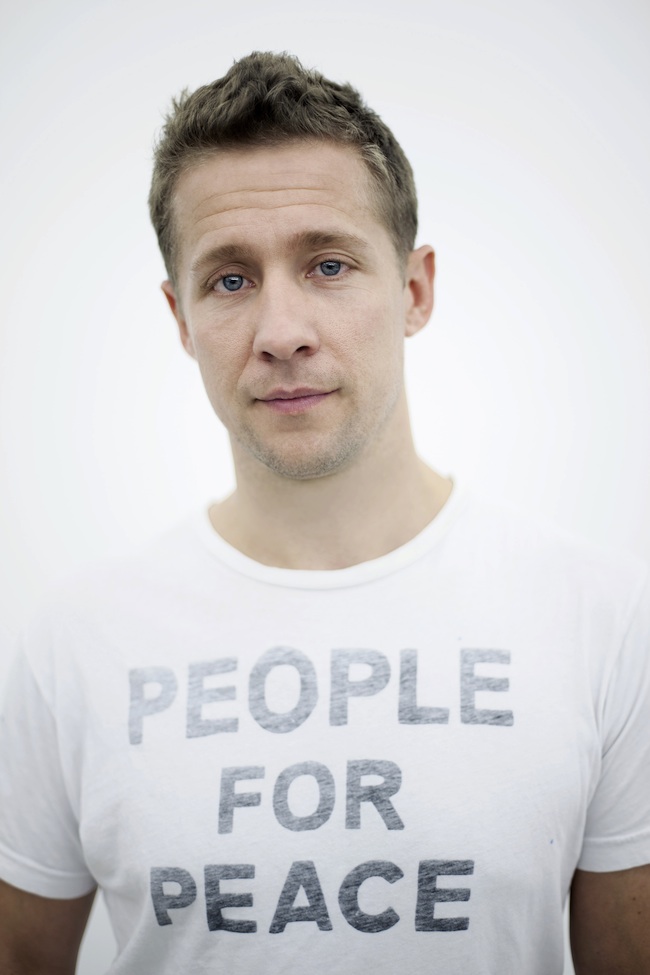
Jeppe Hein. Photo: Philipp Gallon
How did you become an artist? What is your background?
I grew up with the work of Asger Jorn, mostly because I’m related to his family. Asger Jorn was an extremely multifaceted personality with incredible potential; his work was definitely ahead of his time. He was interested in different subjects and politically involved. His work inspired me in manifold ways, but the most striking inspiration for me is that his work was extremely physical. Sometimes you get goose bumps when you look at his work. The physical qualities of his artworks make it easier for people to approach them. Asger Jorn always tried to communicate with the viewer and impart knowledge through his work, often using different kinds of materials and media for this purpose.
My artistic approach is a similar one, and my aim is to reach people by offering them the possibility to participate in the action of a piece.
Tell me a bit about your show at Bonniers Konsthall.
The exhibition, A Smile For You, is a connected solo show at Bonniers Konsthall and Wanås Konst, in Sweden. The shows try to center on the theme “happiness”, by, on the one hand, illustrating my personal journey to happiness, and on the other hand, encouraging viewers to consider their individual idea of happiness – with interactive installations and participatory projects.
Some works appeal to the visitor’s senses; others demand their active involvement. Some create a funny situation, thereby engaging people to start a dialogue with each other; others face the viewer with essential questions that they can only answer on their own. All of them offer people a moment of being “right here, right now”, and put a smile on their faces.
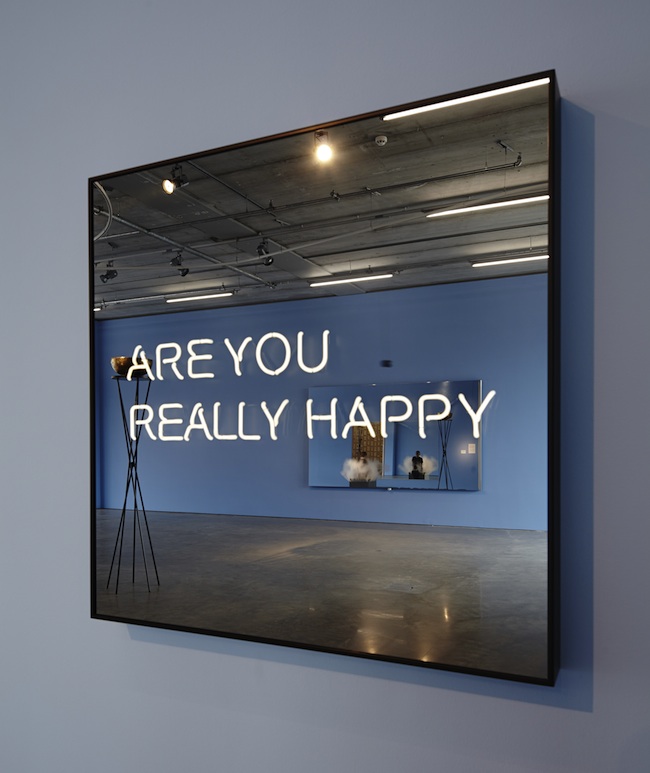
Jeppe Hein. Are You Really Happy. 2013. Photo: Per Kristiansen/Bonniers Konsthall
What was your creative process?
I recently realized that both my life and work have a lot to do with happiness and joy. When we started working on the concept for the shows in Sweden, I decided to focus on this theme, and I started doing comprehensive research. We distributed posters and postcards in Sweden that asked people: What is happiness to you? How does it smell? How does it taste? How does it sound? What does it look like? How does it feel? People returned their responses either by post or email, and a selection will be presented in the exhibition and the accompanying catalog.
I found the diversity among the works interesting: some being industrially made, with a very clean and slick surface; and others being hand-made. What is your relationship to the material? Is it harder to explain a feeling with a clean surface?
Material is a medium for me with which to create a dialog between the viewer and the artwork. Sometimes industrial-made material is suitable for this purpose; sometimes handmade material is the best choice.
Most industrial-made materials, like mirrors or neon tubes, are a part of our everyday life. People are used to it nowadays and interact with it constantly – often without even recognizing it. I try to utilize this unnoticed acquaintance and growing acceptance in my installations – to attract people’s attention.
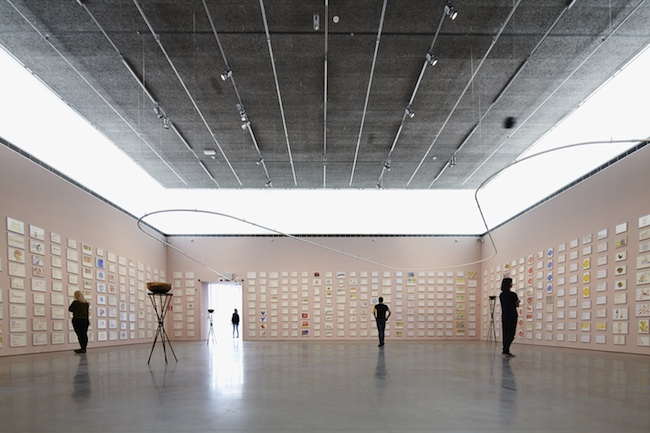
Jeppe Hein. Path of Frequences. 2012. Photo: Per Kristiansen/Bonniers Konsthall
One of the more fascinating pieces in the show – the watercolors – creates a kind of diary; why do you write in English?
I also do write in Danish and German sometimes, but it’s somehow easier for me to write down my thoughts in English when painting a watercolor.
Personally, I wouldn't want anyone to read my diary. Is it strange to put these on show?
Sure. I also made a series of watercolors on the days before and after the show, that illustrate my mixed feelings. Still, it is a part of my artistic biography that I did not want to hide.
Why is “happiness” interesting for art?
For most people, the biggest aim in life is the pursuit of happiness. However, the definition of happiness varies a lot, and it is rather difficult to find a common ground for the key to happiness. If you ask people - What makes you happy, and how does it feel to be happy? - you will receive a wide range of answers because happiness is a very individual feeling.
Still, there is broad consensus that happiness can be stimulated in a way. It can be a constant feeling aroused by love and through social relationships, for example; or a short moment activated by sensory stimulus – a specific smell, taste, sound or something similar. It is said that the perpetual search for such experiences, even if it takes just a blink of an eye, can make you happy in the long run.
The universal, and at the same time, extremely personal meaning of happiness in life, in connection with the possibility to create situations that promote a happy mood somehow, aroused my interest in dealing with this topic on different levels. Planned as future-orientated research, the intention is to approach the theme from an artistic point of view, and to share the diverse perceptions – knowing well that there will not be an exclusive road to happiness as a result, but maybe an index of streets.
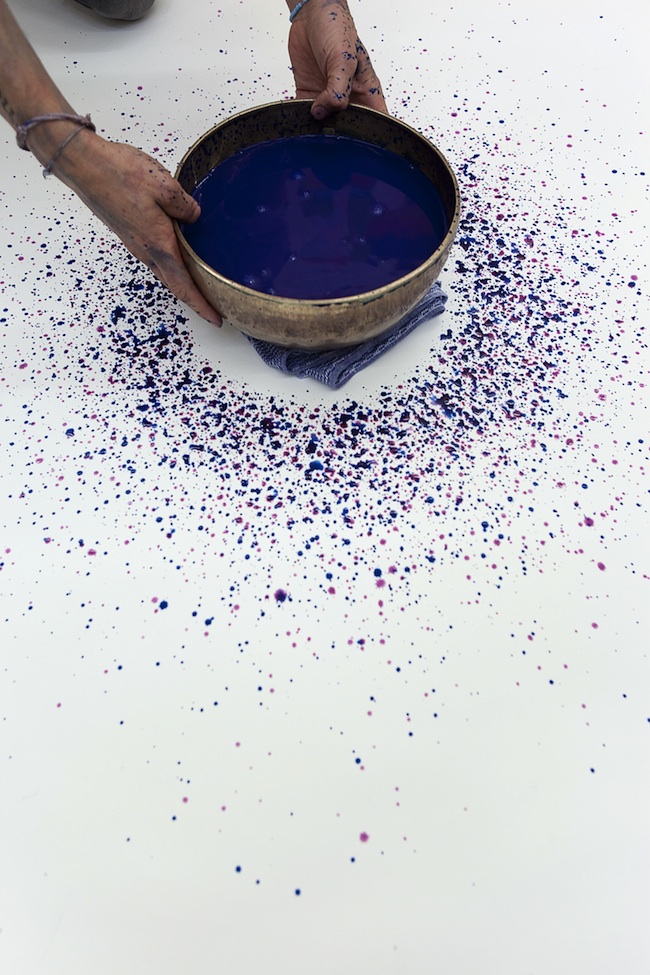
Jeppe Hein. Singing Bowl Watercolour. Work in Progress. Foto: Phillip Gallon
Audience participation seems to be a reoccurring part in your works; why is it important, or isn't it?
For me, the concept of sculpture is closely linked with communication. Rather than passive perception and theoretical reflection, the visitor’s direct and physical experiences are important to me. Thus, one of the most outstanding characteristics of my artworks is their interactivity. The viewer plays a vital role, and my installations offer the possibility of participation in the action of a piece, and of being confronted with the surprise of the unexpected. By challenging the physical attention of the viewer, an active dialogue among the artwork, the surroundings and the other visitors is established, and that lends the sculpture a social quality.
When you do public work, what do you consider then? Does it differ from your other work?
The open character of public spaces offers the opportunity to work in a very conceptual way. Without any institutional restrictions, the conditions of nature, space, the public and the surroundings can be reflected, and then translated, into an artistic idea. Moreover, artworks in public spaces open up new possibilities for the viewer to lose his timidity and respect towards art.
When people see an art piece developed and integrated into a public space, it is often easier for them to get first-hand access to it.
In my opinion, art can be a tool to create a system of reference between the space and the viewer, with which I then attempt to break traditional attitudes and expectations of art. Art, similar to architecture, is a way of expression in space with communicative and functional aspects – with the capacity to intervene in the field of social interaction, and to form social constellations. Therefore, I consider art in public as a social sign – with the ability to provoke and challenge communication and reflection.
This is particularly relevant at a time when places for communication – such as free, creative spaces and areas designed to enable interaction and to involve people in a dialogue with the surroundings and others – are absent from most contemporary cities.
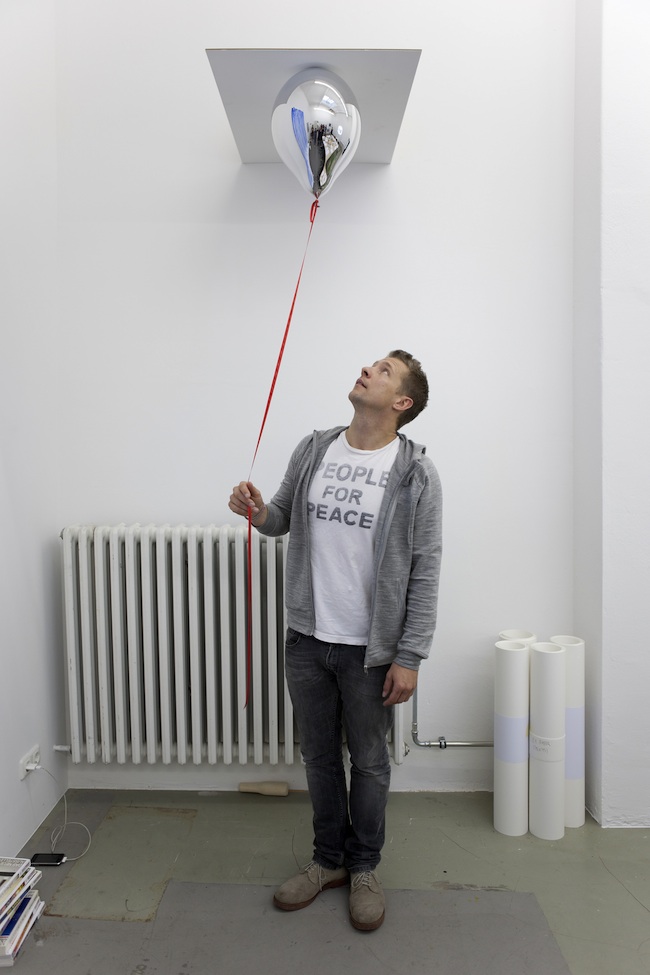
Jeppe Hein. Photo: Philipp Gallon
How do you think that your work has developed over the years?
My personal development, of course, influences my approach to art, and thus, offers new possibilities and ways of creating artworks. If you develop yourself constantly, you will also get new ideas, you will be inspired by other things, and you'll get creative on another level.
What are your plans for the future?
To continue the happiness research, to enjoy how people react to, and interact with, my work, to be able to fascinate them, and sometimes, even to